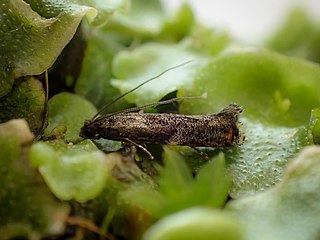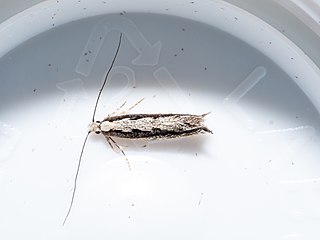
Sabatinca calliarcha is a species of moth belonging to the family Micropterigidae. It was described by Edward Meyrick in 1912. It is endemic to New Zealand. It is found in two separate areas of New Zealand - the first in the northern parts of the North Island including Great Barrier Island and the second population can be found from the top of the South Island down to Southland. The adults of the species are on the wing from the end of September until the middle of January. The species prefers to inhabit damp forests and larvae likely feed on leafy liverwort species. Adult moths likely feed on the spores of ferns or the pollen of sedge grasses.

Erechthias chionodira is a species of moth of the family Tineidae. It was first described by Edward Meyrick in 1880. This species is endemic to New Zealand and has been observed on both the North and South Islands. E. chionodira inhabits native forest. Larvae likely feed on dead plant debris or on the tough leaves of plants such as flax. Adults are on the wing from September until February. During the day they can be seen at rest on tree trunks or fences. Adults are attracted to light.

Amblyptilia deprivatalis is a moth of the family Pterophoridae. This species was first described by Frances Walker in 1864. It is endemic to New Zealand and is found in the North and South Islands. Adults are on the wing from October to May and have an affinity to species in the genus Senecio.

Erechthias lychnopa is a species of moth in the family Tineidae. This species is endemic to New Zealand and has only been collected in a karaka grove at Sinclair Head in Wellington in November. It has yet to be collected again. It has been hypothesised that the larvae inhabit dead wood. It is classified as "Data Deficient" by the Department of Conservation.

Erechthias acrodina is a species of moth of the family Tineidae. This species was first described by Edward Meyrick. It is endemic to New Zealand and is found in the North, South and the Chatham Islands. This species inhabits native forest often near Phormium species and have also been observed on dead Leptospermum scrub. Larvae has been reared from decaying Phormium leaves. Adults are on the wing from October to February.

Erechthias charadrota is a species of moth in the family Tineidae. It was first described by Edward Meyrick in 1880. This species is endemic to New Zealand and is found on both the North and South Islands. It inhabits native forest and the larvae likely feed on either deceased plant detritus or tough leaves of plants such as palms or flax. Adults are on the wing commonly from October to February and it is likely this species has two broods per year. Adults have been trapped via a blacklight.

Erechthias chasmatias is a species of moth in the family Tineidae. It was first described by Edward Meyrick in 1880. This species is endemic to New Zealand and is found in the North Island. This species inhabits native bush. Adults are on the wing from October to April and have been collected by beating small trees and foliage.

Erechthias crypsimima is a species of moth in the family Tineidae. It was described by Edward Meyrick in 1920. This species is endemic to New Zealand and has been observed in the North Island. This species inhabits native forest and has been observed in Nothofagus fusca forest. The larvae likely feed on either deceased plant detritus or tough leaves of plants such as palms or flax. Adults are on the wing commonly from January to March. During the day adults are known to rest of tree trunks where the moth's colouration helps provide protection by camouflaging the moth.

Erechthias decoranda is a species of moth in the family Tineidae. It was described by Edward Meyrick in 1925. This species is endemic to New Zealand and has been observed in the Chatham Islands. Larvae of species in the genus Erechthias feed on dead plant debris or the tough leaves of plants such as palms. Adults are on the wing in October, December and March.

Erechthias exospila is a species of moth of the family Tineidae. It was first described by Edward Meyrick in 1901. It is endemic to New Zealand and can be found in the North Island as well as the Poor Knights and D'Urville Islands. This species inhabits native forest. Larvae of species in the genus Erechthias feed on dead plant debris or the tough leaves of plants such as palms. E. exospila frequents the dead leaves of Astelia. Adults have been observed in November and February. Specimens of this species have been collected via malaise trap and beating shrubs.

Erechthias externella is a species of moth in the family Tineidae. It was described by Francis Walker in 1864. This species is endemic to New Zealand and is found in the North and South Islands. This species inhabits native scrub. The larvae likely feed on either deceased plant detritus or tough leaves of plants such as palms or flax. Adults are sun-lovers and appear on the wing in October. They actively fly in the afternoon when their movements are rapid and can be hard to follow. They have also been trapped using blacklight.

Erechthias fulguritella is a species of moth in the family Tineidae. It was first described by Francis Walker in 1863. This species is endemic to New Zealand and can be found in both the North and South Islands. It inhabits native forest and scrub. Larvae of this species likely feed on dead plant debris and they have been observed feeding amongst the dead cones of Pinus radiata. Adults are on the wing from October to February and are variable in appearance both in colour and in wing markings.

Erechthias hemiclistra is a species of moth of the family Tineidae. It was first described by Edward Meyrick in 1911. This species is endemic to New Zealand and has been observed in both the North and South Islands. It inhabits native forest and has an affinity for species in the genera Phormium,Cortaderia and Cordyline, likely as a result of its larvae feeding on dead fibre sourced from plant species in these genera. Adults are on the wing from September to April but are most commonly observed in December and January. Adults are also attracted to light.

Erechthias indicans is a species of moth in the family Tineidae. It was first described by Edward Meyrick in 1923. This species is endemic to New Zealand and has been observed in Wellington in January.

Erechthias macrozyga is a species of moth of the family Tineidae. It was described by Edward Meyrick in 1916. This species is endemic to New Zealand and has been observed in the North and South Islands. This species inhabits lowland native forest. Adult moths are on the wing from October to February.

Erechthias terminella is a species of moth in the family Tineidae. It was first described by Francis Walker in 1863. This species is endemic to New Zealand and can be found throughout the North and in the upper parts of the South Islands. It inhabits native forest. The larvae of E. terminella feed under a web of silk and frass on the seeds as well as possibly the pods of Phormium tenax and are also known to feed on the fruits of plant species such as Meryta sinclairii. Larva are generally sluggish but can be very agile when disturbed. Adults are on the wing throughout the year and are attracted to light.

Tingena chloradelpha is a species of moth in the family Oecophoridae. It is endemic to New Zealand and can be found in the North and South Islands. The larvae live underground forming silken tubes from which it feeds. It overwinters in these tubes and then pupates enclosed in a weak pale white silken cocoon. The adults of this species is variable in appearance both in the depth of colour as well as in its discal spots which may in some specimens be lacking. The adults are on the wing from October until the end of December and can be found inhabiting domestic gardens as well as cultivated land. They have been seen resting on window frames and can be found inside houses.

Tortrix fervida is a species of moth of the family Tortricidae. It is endemic to New Zealand and has been observed in both the North and South Islands. The larvae feed on species of fern in the genus Hymenophyllum including Hymenophyllum nephrophyllum. The adult moths are variable in appearance and are day flying. They are on the wing from November until January. This species is regarded as being uncommon.

Atomotricha isogama is a moth in the family Oecophoridae. It was first described by Edward Meyrick in 1909. This species is endemic to New Zealand and has been observed in the North and South Islands. Larvae are leaf litter feeders and have been recorded as emerging in the New Zealand spring. Adults have been observed on the wing from July to January.

Orthenches prasinodes is a moth of the family Plutellidae. It was first described by Edward Meyrick in 1885. This species is endemic to New Zealand and has been observed in both the North and South Islands in the Wellington, Canterbury and Southland regions. It inhabits native forest. The larval host are species in the genus Muehlenbeckia and larvae have been raised on Muehlenbeckia complexia. Adults are on the wing from December until March.






















